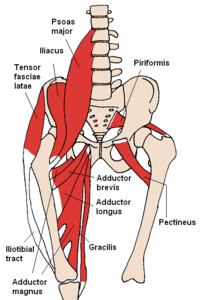
Photo from wikipedia
Background Groin wound infections in vascular surgery are still a common complication and challenging problem. This systematic review aimed to establish a complete view of patient characteristics and clinical outcomes… Click to show full abstract
Background Groin wound infections in vascular surgery are still a common complication and challenging problem. This systematic review aimed to establish a complete view of patient characteristics and clinical outcomes for infected groin wounds following vascular surgery reconstruction using muscle flaps and to evaluate the differences in outcomes between the sartorius muscle flap (SMF), rectus femoris muscle flap (RFF), and gracilis muscle flap (GMF). Methods PubMed, Scopus, and Web of Science were systematically searched from inception to April 2021. Random-effects meta-analysis for comorbidities and outcomes and subgroup analyses for outcomes were performed. Results Thirty studies were included in qualitative and quantitative syntheses. Overall pooled data showed the following outcome rates: 4.5% muscle flap necrosis (95% confidence interval [CI], −3.4–12.3%; I 2 = 0%), 21.8% overall complications (95% CI, 15.8–27.7%; I 2 = 0%), 8.0% limb loss (95% CI, 1.9–14.1%; I 2 = 0%), 15.4% graft loss (95% CI, 5.0–25.3%; I 2 = 37.9%), and 7.4% 30-day mortality (95% CI, −.9–15.6%; I 2 = 0%). The rates of overall complications were 20.3% (95% CI, 12.1–28.2%; I 2 = 0%), 23.2% (95% CI, 11.2–34.5%; I 2 = 10.2%), and 18.0% (95% CI, −3.537.8%; I 2 = 0%) for the SMF, RFF, and GMF, respectively. The rate of limb loss was highest for the GMF (17.2%; 95% CI, −4.237.2%; I 2 = 0%). The rate of graft loss for the RFF was the highest (20.7%; 95% CI, .6–39.1%; I 2 = 53.9%). The rate of 30-day mortality was the lowest for the SMF (5.3%; 95% CI, −6.1–16.6%; I 2 = 0%). Conclusions The effectiveness and safety of muscle flap reconstruction for infected groin wounds following vascular surgery are clearly positive. This review indicated a tendency for lower complication rates with the SMF than with other muscle flaps.
Journal Title: Vascular and Endovascular Surgery
Year Published: 2022
Link to full text (if available)
Share on Social Media: Sign Up to like & get
recommendations!